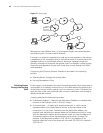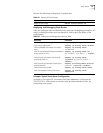
IP Routing Protocol Overview 83
■ The output interface — Indicates an interface through which an IP packet
should be forwarded.
■ The next hop address — Indicates the next router that an IP packet will pass
through.
■ The priority added to the IP routing table for a route — Indicates the type of
route that is selected. There may be multiple routes with different next hops to
the same destination. These routes can be discovered by different routing
protocols, or they can be the static routes that are configured manually. The
route with the highest priority (the smallest numerical value) is selected as the
current optimal route.
Routes are divided into two types: subnet routes, in which the destination is a
subnet, or host routes, in which the destination is a host.
In addition, depending on whether the network of the destination host is directly
connected to the router, there are two types of routes:
■ Direct route: The router is directly connected to the network where the
destination is located.
■ Indirect route: The router is not directly connected to the network where the
destination is located.
To limit the size of the routing table, an option is available to set a default route.
All the packets that fail to find a suitable table entry are forwarded through this
default route.
In a complicated Internet, as shown in the following figure, the number in each
network is the network address. The router R8 is connected to three networks, so
it has three IP addresses and three physical ports. Its routing table is shown in
Figure 23.
Figure 23 The Routing Table
Routing Management
Policy
The Switch 7750 supports the configuration of a series of dynamic routing
protocols such as RIP, as well as static routes. The static routes configured by the
R2
R3
R4
R5
R6
R7
R8
R1
10.0.0
10.0.0.2
10.0.0.2
10.0.0.2
10.0.0.1
10.0.0.0
11.0.0.2
11.0.0.2
11.0.0.1
11.0.0.0
11.0.0
12.0.0.0
12.0.0.1
12.0.0.3
12.0.0.2
12.0.0
13.0.0.0
13.0.0.3
13.0.0.4
13.0.0.1
13.0.0.2
13.0.0.2
13.0.0
14.0.0.0
14.0.0.1
14.0.0.2
14.0.0
15.0.0.0
15.0.0.2
15.0.0.1
15.0.0
16.0.0
16.0.0.0
16.0.0.3
16.0.0.2
16.0.0.3
16.0.0.2
Destination
host
location
Forwarding
router
Port
passed
Directly
Directly
Directly
3
2
2
2
3
1
1


















